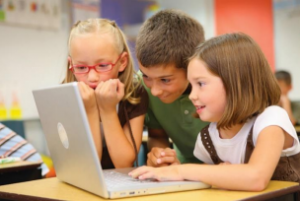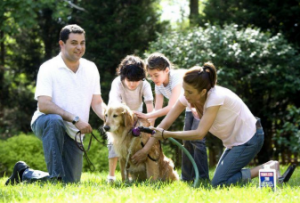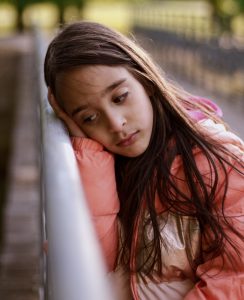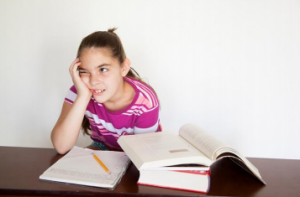17 Emotional Development in Middle Childhood
Chapter Objectives
After this chapter, you should be able to:
- Describe the continuum of development of emotional skills during middle childhood
- Discuss Kohlberg’s Stages of Moral Development
- Discuss childhood mental health issues
- Explain resilience
- Describe self-understanding, motivation self-efficacy in middle childhood
- Explain gender identity
INTRODUCTION
As children get older their experiences allow them to develop a more realistic understanding of themselves, including both their strengths and weaknesses. This developing self-concept is influenced by messages they receive from their peers, their family, other adults in their lives such as teachers and coaches, and the media.
Continuum of Development
The Continuum of Development identifies several root emotional skills that are emerging in children between 5 and 8 years of age. During these years, children are solidifying their self-concept, identity and self-esteem. They start to define themselves by comparing themselves to others and are becoming more aware of stereotypes. They are better able to recognize and understand complex emotions such as gratitude, jealousy and anxiety. They now have a variety of strategies for managing their emotions, such as self-talk, empathy and perspective-taking. They often take great pride in their work and their new-found abilities to persevere and solve problems (Ontario Ministry of Education, 2014a).
Between the ages of 9 and 12, improving metacognitive skills (the awareness of their own thought processes) enable children to understand their emotional selves. They are also better at anticipating future outcomes which allows them to be better prepared for managing emotional situations. However, tweens can still struggle to manage their emotions if they feel overwhelmed by strong emotions such as frustration or by the demands of the situation (Ontario Ministry of Education, 2014a).
Lawrence Kohlberg’s Stages of Moral Development
Kohlberg (1963, as cited in Paris, Ricardo, Raymond, & Johnson, 2021) built on the work of Piaget and was interested in finding out how our moral reasoning changes as we get older. He wanted to find out how people decide what is right and what is wrong. Just as Piaget believed that children’s cognitive development follows specific patterns, Kohlberg (1984, as cited in Paris, Ricardo, Raymond, & Johnson, 2021) argued that we learn our moral values through active thinking and reasoning, and that moral development follows a series of stages. Kohlberg’s six stages are generally organized into three levels of moral reasoning. To study moral development, Kohlberg looked at how children (and adults) respond to moral dilemmas.
One of Kohlberg’s best-known moral dilemmas is the Heinz dilemma: In Europe, a person was near death from a special kind of cancer. There was one drug that the doctors thought might save them. It was a form of radium that a druggist in the same town had recently discovered. The drug was expensive to make but the druggist was charging ten times what the drug cost them to make. The druggist paid $200 for the radium and charged $2,000 for a small dose of the drug. The sick person’s spouse, Heinz, went to everyone they knew to borrow the money but they could only get together about $1,000, about half of what the drug cost. They told the druggist that their spouse was dying and asked them to sell it cheaper or let them pay later. But the druggist said: “No, I discovered the drug and I’m going to make money from it.” Heinz got desperate and broke into the druggist store to steal the drug for their sick spouse. Should the person have done that? (Kohlberg, 1969, p. 379, as cited in Paris, Ricardo, Raymond, & Johnson, 2021).
Level One – Preconventional Morality
In stage one, moral reasoning is based on concepts of punishment. The child believes that if the consequence for an action is punishment, then the action was wrong. In the second stage, the child bases their thinking on self-interest and reward (“You scratch my back, I’ll scratch yours”). The youngest subjects seemed to answer based on what would happen to the spouse as a result of the act. For example, they might say the spouse should not break into the pharmacy because the pharmacist might find them and beat them. Or they might say that the spouse should break in and steal the drug and the sick spouse will give them a big kiss. Right or wrong, both decisions were based on what would physically happen as a result of the act. This is a self-centered approach to moral decision-making. They called this most superficial understanding of right and wrong preconventional morality. Preconventional morality focuses on self-interest. Punishment is avoided and rewards are sought. Adults can also fall into these stages, particularly when they are under pressure.
Level Two – Conventional Morality
Those tested who based their answers on what other people would think of the spouse as a result of the act were placed in Level Two. For instance, they might say the spouse should break into the store, then everyone would think they were being a good partner, or the spouse should not because it is against the law. In either case, right and wrong is determined by what other people think. In stage three, the person wants to please others. At stage four, the person acknowledges the importance of social norms or laws and wants to be a good member of the group or society. A good decision is one that gains the approval of others or one that complies with the law. This is called conventional morality; people care about the effect of their actions on others. Some older children, adolescents, and adults use this reasoning.
Level Three, post-conventional morality, is not included because it focuses on adolescence and adulthood. However, it is in the table below if you’d like an overview of Level Three – Stages 5 and 6.
Preconventional Morality (young children)
| Stage | Description |
| Stage 1 | Focus is on self-interest and punishment is avoided. The person shouldn’t steal the drug, as they may get caught and go to jail. |
| Stage 2 | Rewards are sought. A person at this level will argue that the person should steal the drug because they do not want to lose their partner who takes care of them. |
Conventional Morality (older children, adolescents, most adults)
| Stage | Description |
| Stage 3 | Focus is on how situational outcomes impact others and wanting to please and be accepted. The person should steal the drug because that is what good partners do. |
| Stage 4 | People make decisions based on laws or formalized rules. The person should obey the law because stealing is a crime. |
Post Conventional Morality (rare in adolescents, a few adults)
| Stage | Description |
| Stage 5 | Individuals employ abstract reasoning to justify behaviours. The person should steal the drug because laws can be unjust and you have to consider the whole situation. |
| Stage 6 | Moral behaviour is based on self-chosen ethical principles. The person should steal the drug because life is more important than property. |
Although research has supported Kohlberg’s idea that moral reasoning changes from an early emphasis on punishment and social rules and regulations to an emphasis on more general ethical principles, as with Piaget’s approach, Kohlberg’s stage model is probably too simple. For one, people may use higher levels of reasoning for some types of problems but revert to lower levels in situations where doing so is more consistent with their goals or beliefs (Rest, 1979, as cited in Paris, Ricardo, Raymond, & Johnson, 2021). Second, it has been argued that the stage model is particularly appropriate for Western, rather than non-Western, samples in which allegiance to social norms, such as respect for authority, may be particularly important (Haidt, 2001). In addition, there is frequently little correlation between how we score on the moral stages and how we behave in real life. Finally, critics of Kohlberg’s theory believe that it is gender-biased. Typical male approaches to making a moral decision are given a higher rating (Level 4) than typical female approaches (Level 3). Males tend to make moral decisions based on principles of law and order. Females tend to make moral decisions based on interpersonal interactions. Critics say that one approach is not better or worse than the other, just different.
Indigenous Perspectives
In many Indigenous nations children learn the Seven Grandfather Teachings which are values and they are taught morals through Storytelling. In the story, one or more of the animals learns a valuable lesson. The child sees himself in the animal characters of the story.
self understanding
Children in middle childhood have a more realistic sense of self than do those in early childhood. That exaggerated sense of self as “biggest” or “smartest” or “tallest” gives way to an understanding of one’s strengths and weaknesses. This can be attributed to greater experience in comparing one’s own performance with that of others and to greater cognitive flexibility. A child’s self-concept can be influenced by peers and family and the messages they send about a child’s worth. Contemporary children also receive messages from the media about how they should look and act. Movies, music videos, the internet, and advertisers can all create cultural images of what is desirable or undesirable and this too can influence a child’s self-concept.

Figure 17.1: Interactions with the media influence children’s perception of themselves. (Image by Lucélia Ribeiro is licensed under CC BY-SA 2.0)
Young children begin developing social understanding very early in life and are also able to include other peoples’ appraisals of them into their self-concept, including parents, teachers, peers, culture, and media. Internalizing others’ appraisals and creating social comparison affect children’s self-esteem, which is defined as an evaluation of one’s identity. Children can have individual assessments of how well they perform a variety of activities and also develop an overall, global self-assessment. If there is a discrepancy between how children view themselves and what they consider to be their ideal selves, their self-esteem can be negatively affected.
Self-concept refers to beliefs about general personal identity (Seiffert, 2011, as cited in Paris, Ricardo, Raymond, & Johnson, 2021). These beliefs include personal attributes, such as one’s age, physical characteristics, behaviours, and competencies. Children in middle and late childhood have a more realistic sense of self than do those in early childhood, and they better understand their strengths and weaknesses. This can be attributed to greater experience in comparing their own performance with that of others, and to greater cognitive flexibility.
Another important development in self-understanding is self-efficacy, which is the belief that you are capable of carrying out a specific task or of reaching a specific goal (Bandura, 1977, 1986, 1997, as cited in Paris, Ricardo, Raymond, & Johnson, 2021). Large discrepancies between self-efficacy and ability can create motivational problems for the individual (Seifert, 2011, as cited in Paris, Ricardo, Raymond, & Johnson, 2021). If a student believes that they can solve mathematical problems, then the student is more likely to attempt the mathematics homework that the teacher assigns.
Unfortunately, the converse is also true. If a student believes that they are incapable of math, then the student is less likely to attempt the math homework regardless of the student’s actual ability in math. Since self-efficacy is self-constructed, it is possible for students to miscalculate or misperceive their true skill, and these misperceptions can have complex effects on students’ motivations. It is possible to have either too much or too little self-efficacy, and according to Bandura (1997, as cited in Paris, Ricardo, Raymond, & Johnson, 2021) the optimal level seems to be either at, or slightly above, true ability.

Figure 17.2: Families can support children’s social and emotional skills. (Image is in the public domain)
As we have seen, children’s experience of relationships at home and the peer group contributes to an expanding repertoire of social and emotional skills and also to broadened social understanding. In these relationships, children develop expectations for specific people, understanding of how to interact with adults and peers, and self-concept based on how others respond to them. These relationships are also significant forums for emotional development (Thompson, n.d.).
childhood mental health
Mental health problems can disrupt daily life at home, at school or in the community. Without help, mental health problems can lead to school failure, alcohol or other drug abuse, family discord, violence or even suicide. However, help is available. Talk to your health care provider if you have concerns about your child’s behaviour.
Mental health disorders are diagnosed by a qualified professional using the Diagnostic and Statistical Manual of Mental Disorders (DSM). This is a manual that is used as a standard across the profession for diagnosing and treating mental disorders.
When You Have a Concern About a Child. What’s in a Label?
childhood mental health disorders
social and emotional disorders
- Phobias
- Anxiety
- Post-Traumatic Stress Disorder – PTSD
- Obsessive Compulsive Disorder- OCD
- Depression
Developmental disorders
- Autism Spectrum Disorder (ASD)
- Attention Deficit Disorder (ADHD)
- Pervasive Developmental Disorder (PDD)
Phobias
When a child who has a phobia (an extreme or irrational fear of or aversion to something which is out of proportion to the risk it presents) is exposed to the phobic stimulus (the stimuli varies), it almost invariably provokes an immediate anxiety response, which may take the form of a situational bound or situational predisposed panic attack. Children can show effects and characteristics when it comes to specific phobias. The effects of anxiety show up by crying, throwing tantrums, experiencing freezing, or clinging to the parent that they have the most connection with. Related conditions include anxiety. Common childhood phobias include a fear of certain animals and insects, a fear of blood and a fear of needles.
anxiety
Many children have fears and worries, and will feel sad and hopeless from time to time. Strong fears will appear at different times during development. For example, toddlers are often very distressed about being away from their parents, even if they are safe and cared for. Although fears and worries are typical in children, persistent or extreme forms of fear and sadness feelings could be due to anxiety or depression. Because the symptoms primarily involve thoughts and feelings, they are called internalizing disorders.

Figure 17.3: An anxious child (Photo by Zika Radosavljevic on Unsplash)
When children do not outgrow the fears and worries that are typical in young children, or when there are so many fears and worries that interfere with school, home, or play activities, the child may be diagnosed with an anxiety disorder.
Examples of different types of anxiety disorders include:
- Being very afraid when away from parents (separation anxiety)
- Having extreme fear about a specific thing or situation, such as dogs, insects, or going to the doctor (phobias)
- Being very afraid of school and other places where there are people (social anxiety)
- Being very worried about the future and about bad things happening (general anxiety)
- Having repeated episodes of sudden, unexpected, intense fear that come with symptoms like heart pounding, having trouble breathing, or feeling dizzy, shaky, or sweaty (panic disorder)
Anxiety may present as fear or worry, but can also make children irritable and angry. Anxiety symptoms can also include trouble sleeping, as well as physical symptoms like fatigue, headaches, or stomachaches. Some anxious children keep their worries to themselves and, thus, the symptoms can be missed. Related conditions include Obsessive-Compulsive Disorder and Post Traumatic Stress Disorder.
Post-Traumatic Stress Disorder (PTSD)
Exposure to traumatic events such as actual or threatened death, serious injury or sexual violation can have major developmental influences on children. While the majority of children will not develop PTSD after a trauma, best estimates from the literature are that around a third of them will, higher than adult estimates. Some reasons for this could include more limited knowledge about the world, differential coping mechanisms employed, and the fact that children’s reactions to trauma are often highly influenced by how their parents and caregivers react.
The impact of PTSD on children weeks after a trauma, show that up to 90% of children may experience heightened physiological arousal, diffuse anxiety, survivor guilt, and emotional liability. These are all normal reactions and should be understood as such (similar things are seen in adults). Those children still having these symptoms three or four months after a disaster, however, may be in need of further assessment, particularly if they show the following symptoms as well. For older children, warning signs of problematic adjustment include: repetitious play reenacting a part of the disaster; preoccupation with danger or expressed concerns about safety; sleep disturbances and irritability; anger outbursts or aggressiveness; excessive worry about family or friends; school avoidance, particularly involving somatic complaints; behaviours characteristic of younger children; and changes in personality, withdrawal, and loss of interest in activities.
Obsessive Compulsive Disorder (OCD)
Although a diagnosis of OCD requires only that a person either has obsessions or compulsions, not both, approximately 96% of people experience both. For almost all people with OCD, being exposed to a certain stimuli (internal or external) will then trigger an upsetting or anxiety-causing obsession, which can only be relieved by doing a compulsion. For example, a person touches a doorknob in a public building, which causes an obsessive thought that they will get sick from the germs, which can only be relieved by compulsively washing their hands to an excessive degree. Some of the most common obsessions include unwanted thoughts of harming loved ones, persistent doubts that one has not locked doors or switched off electrical appliances, intrusive thoughts of being contaminated, and morally or sexually repugnant.
depression
Occasionally being sad or feeling hopeless is a part of every child’s life. However, some children feel sad or uninterested in things that they used to enjoy, or feel helpless or hopeless in situations where they could do something to address the situations. When children feel persistent sadness and hopelessness, they may be diagnosed with depression.

Figure 17.4: Persistent sadness is a symptom of depression. (Photo by Zhivko Minkov on Unsplash)
symptoms
We now know that youth who have depression may show signs that are slightly different from the typical adult symptoms of depression. Children who are depressed may complain of feeling sick, refuse to go to school, cling to a parent or caregiver, feel unloved, hopelessness about the future, or worry excessively that a parent may die. Older children and teens may sulk, get into trouble at school, be negative or grouchy, are irritable, indecisive, have trouble concentrating, or feel misunderstood. Because normal behaviours vary from one childhood stage to another, it can be difficult to tell whether a child who shows changes in behaviour is just going through a temporary “phase” or is suffering from depression.
treatment
With medication, psychotherapy, or combined treatment, most youth with depression can be effectively treated. Youth are more likely to respond to treatment if they receive it early in the course of their illness.
Motivation as Self Efficacy
In addition to being influenced by their goals, interests, and attributions, students’ motives are affected by specific beliefs about the student’s personal capacities. In self-efficacy theory the beliefs become a primary, explicit explanation for motivation (Bandura, 1977, 1986, 1997). Self-efficacy is the belief that you are capable of carrying out a specific task or of reaching a specific goal. As mentioned previously, the optimal level seems to be either at or slightly above true capacity (Bandura, 1997, as cited in Paris, Ricardo, Raymond, & Johnson, 2021). As we indicate below, large discrepancies between self-efficacy and ability can create motivational problems for the individual.
Motivation
Motivation refers to a desire, need, or drive that contributes to and explains behavioural changes. In general, motivators provide some sort of incentive for completing a task. One definition of a motivator explains it as a force “acting either on or within a person to initiate behaviour.” In addition to biological motives, motivations can be either intrinsic (arising from internal factors) or extrinsic (arising from external factors).
Extrinsic vs. Intrinsic Motivation
Intrinsically motivated behaviours are performed because of the sense of personal satisfaction that they bring. According to Deci (1971, as cited in Paris, Ricardo, Raymond, & Johnson, 2021), these behaviours are defined as ones for which the reward is the satisfaction of performing the activity itself. Intrinsic motivation thus represents engagement in an activity for its own sake. For example, if comforting a friend makes a child feel good, they are intrinsically motivated to respond to their friend’s distress.
Extrinsically motivated behaviours, on the other hand, are performed in order to receive something from others or avoid certain negative outcomes. The extrinsic motivator is outside of, and acts on, the individual. Rewards—such as a sticker, or candy—are good examples of extrinsic motivators. Social and emotional incentives like praise and attention are also extrinsic motivators since they are bestowed on the individual by another person.
In general, intrinsic motivation tends to be more long-lasting and can increase the desire to learn. Extrinsic motivation is more fleeting, only lasting as long as the reward is offered.

Figure 17.5: A lollipop can be an extrinsic motivator. (Image by strausadolf on Pixabay)
Learned Helplessness and Self-Efficacy
If a person’s sense of self-efficacy is very low, they can develop learned helplessness, a perception of complete lack of control in mastering a task. The attitude is similar to depression, a pervasive feeling of apathy and a belief that effort makes no difference and does not lead to success. Learned helplessness was originally studied from the behaviourist perspective of classical and operant conditioning by the psychologist Martin Seligman (1995, as cited in Paris, Ricardo, Raymond, & Johnson, 2021). In people, learned helplessness leads to characteristic ways of dealing with problems. They tend to attribute the source of a problem to themselves, to generalize the problem to many aspects of life, and to see the problem as lasting or permanent. More resilient individuals, in contrast, are more likely to attribute a problem to outside sources, to see it as specific to a particular situation or activity, and to see it as temporary or time-limited. Consider, for example, two students who each fail a test. The one with a lot of learned helplessness is more likely to explain the failure by saying something like: “I’m stupid; I never perform well on any schoolwork, and I never will perform well at it.” The other, more resilient student is more likely to say something like: “The teacher made the test too hard this time, so the test doesn’t prove anything about how I will do next time or in other subjects.”

Figure 17.6: If this child thinks that studying won’t help them do well on the test, then low self-efficacy may develop into learned helplessness. (Image by amenclinicsphotos ac is licensed under CC BY-SA 2.0)
What is noteworthy about these differences in perception is how much the more resilient of these perspectives resembles high self-efficacy and how much learned helplessness seems to contradict or differ from it. As already noted, high self-efficacy is a strong belief in one’s capacity to carry out a specific task successfully. By definition, therefore, self-efficacy focuses attention on a temporary or time-limited activity (the task), even though the cause of successful completion (oneself) is “internal.”
Resilience
Resilient children have developed internal processes that enable them to cope with challenges. Children who haven’t yet developed these processes are sometimes mis-labelled as lacking in self-control. Resilience stems from self-regulation, not self-control. Resilient children know what their stressors are, can recognize signs they are becoming over-stressed, and have strategies for reducing stress. Resiliency is not static; it is not unusual for a child to be able to cope with set-backs in some situations but not in others. According toHow Does Learning Happen?: “Educators can play an important role in supporting self-regulation by providing environments that reduce stressors while recognizing and supporting children’s efforts and increasing ability to self-regulate. Educators can also support children’s developing ability to self-regulate by being responsive and attuned to children’s individual cues, arousal states, and responses to various stressors. And they can help children learn strategies for becoming or staying calm and focused by enabling them to recognize and modulate their emotional states and impulses and become more aware of the effects of their actions on others.” (Ontario Ministry of Education, 2014b)
Ontario’s foundational document, The Kindergarten Program (2016), builds on the concepts set out in How Does Learning Happen?. According to this document, children’s ability to self-regulate “is essential to the development of learning skills and work habits”. A play-based kindergarten learning environment supports children’s emerging ability to self-regulate by, for example, providing a variety of activities and spaces within the classroom to help children learn how choose between stimulating or calming ones and by modelling of self-regulation strategies by the classroom educators (Ontario Ministry of Education, 2016). Development of self-regulation skills continues through middle childhood.
Dr. Stuart Shanker has identified five domains of self-regulation:
- Biological: the ability to control one’s level of energy to match the situation
- Emotional: the ability to modify intense emotional responses
- Cognitive: the ability to stay focused and ignore distractions
- Social: the ability to respond appropriately to social cues
- Prosocial: the ability to empathize (Shanker, 2021).
Gender Identity
The development of gender and gender identity is likewise an interaction among social, biological, and representational influences (Ruble, Martin, & Berenbaum, 2006, as cited by Paris, Ricardo, Raymond, & Johnson, 2021). Young children learn about gender from parents, peers, and others in society, and develop their own conceptions of the attributes associated with maleness or femaleness (called gender schemas). They also negotiate biological transitions (such as puberty) that cause their sense of themselves and their sexual identity to mature.

Figure 17.7: Social influences such as cultural norms impact children’s interests, dress, style of speech and even life aspirations. (Image by Amanda Westmont is licensed under CC BY-NC-SA 2.0)
Each of these examples of the growth of social and emotional competence illustrates not only the interaction of social, biological, and representational influences but also how their development unfolds over an extended period. Early influences are important, but not determinative because the capabilities required for mature moral conduct, gender identity, and other outcomes continue to develop throughout childhood, adolescence, and even the adult years.
As the preceding sentence suggests, social and personality development continues through adolescence and the adult years, and it is influenced by the same constellation of social, biological, and representational influences discussed for childhood. Changing social relationships and roles, biological maturation and how the individual represents both experience and the self, continue to form the bases for development throughout life. In this respect, when an adult looks forward rather than retrospectively to ask, “What kind of person am I becoming?”—A similarly fascinating, complex, multifaceted interaction of developmental processes lies ahead (Thompson, 2022).
Summary
- The continuum of development of emotional skills during middle childhood
- Kohlberg’s stages of moral development
- childhood mental health issues
- How school-age children continue to develop their self-understanding
- Self-efficacy and learned helplessness
- Resilience
- Gender identification
References
Ontario Ministry of Eduction. (2014a). Excerpts from “Elect”. Retrieved from https://www.dufferincounty.ca/sites/default/files/rtb/Excerpts-from-Early-Learning-for-Every-Child-Today.pdf
Ontario Ministry of Education. (2014b). How does learning happen? Ontarios pedagogy for the early years. Retrieved from https://files.ontario.ca/edu-how-does-learning-happen-en-2021-03-23.pdf
Ontario Ministry of Education. (2016). The kindergarten program. Retreived from https://files.ontario.ca/books/kindergarten-program-en.pdf?_ga=2.202583506.2105092635.1644423426-2023522704.1644423426
Shanker, S. (2021). Self regulation: The 5 domains of self reg. Retrieved from https://self-reg.ca/wp-content/uploads/2021/05/infosheet_5-Domains-of-Self-Reg.pdf
Thompson, R. (2022). Social and personality development in childhood. Retrieved from http://noba.to/gdqm6zvc

